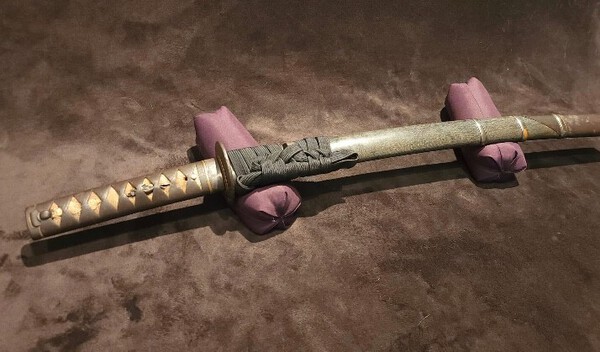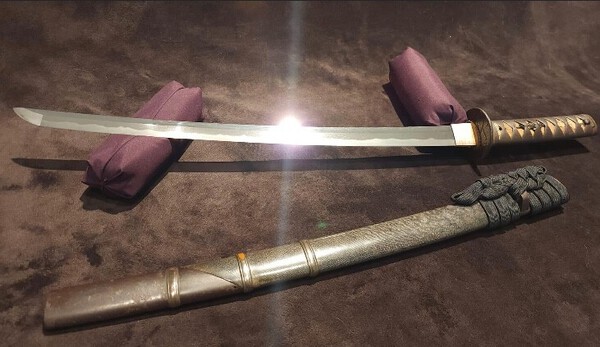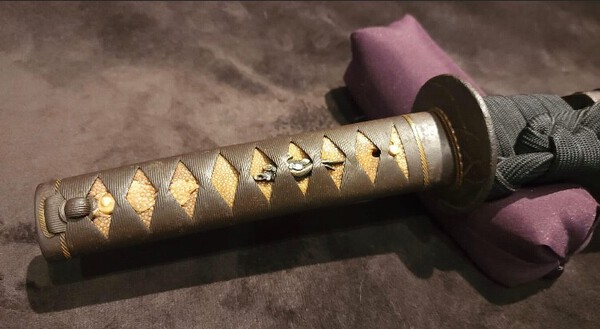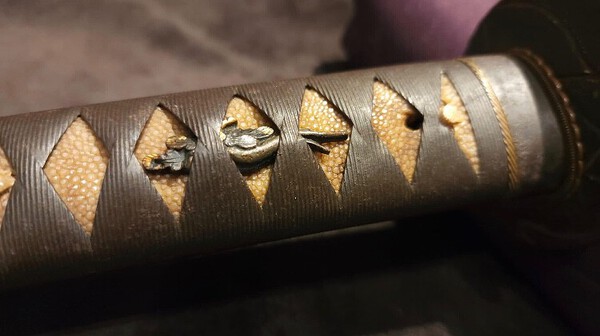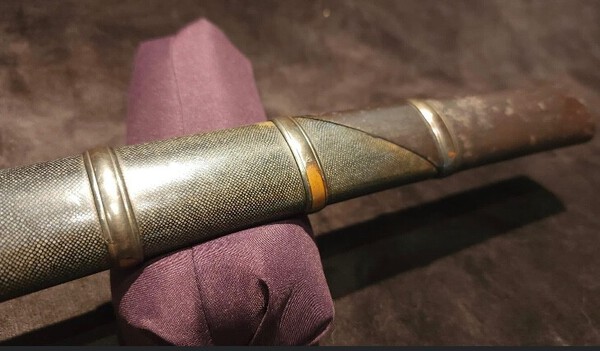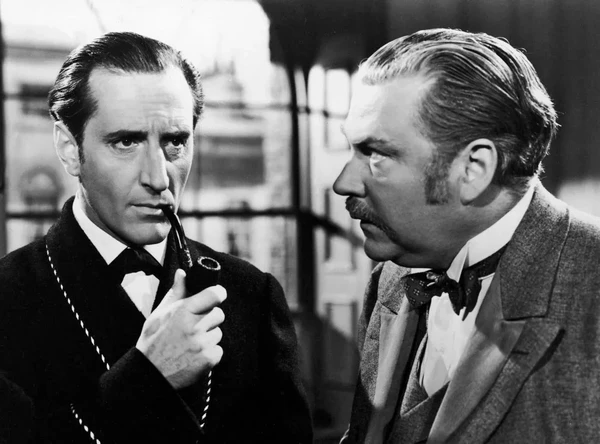-
Posts
235 -
Joined
-
Last visited
Content Type
Profiles
Forums
Events
Store
Downloads
Gallery
Everything posted by WillFalstaff
-
I hate to say it, and I might be wrong, but the nakago (tang) looks cleaned which decreases value. Aside from that, its usual for nihonto accoutrement to be added to old blades as the years and centuries go by, so the worth of the sword is in the blade, then in the tsuba, fuchi-koshirae, by-blades, chop sticks, ear wax cleaners, etc.
-
@NewB That’s tough to determine. “The Art of the Japanese Sword” by the Kapps and Yoshihara has pictures of how the hi are added. It can easily be done to old swords, and to fresh ones from the smith, as the shinogi ji is softer un-hardened metal.
-
The shinogi ji being unburnished is an alarm bell.
-
Congrats on the daisho! The blades are what makes this story a fairy tale come true. Tsukas aside, the fittings are nice. Are you planning on having the handles and all rewrapped/conditioned?
-
So, the beefcake sword on the left is the Japanese sword. Cannot tell if it is a traditionally made sword as that would need detailed pics as NewB said above. At top is what looks like an early 1800’s foot artillery man’s short sword. To the right of the Japanese sword are most likely a European sword, then a Civil War era calvary saber, and a machete in a sheath. I think some of the folks on here can guide you to forums and websites that deal with non-Japanese items. Good luck!
-

Documentary « the soul of the KATANA »
WillFalstaff replied to French nihonto's topic in General Nihonto Related Discussion
Great short documentary! Very well produced. -
It’s a piece of wood meant as a place-holder. Plane it down. Probably an issue with wood swelling. Don’t sweat it. Don’t use sand paper because it could leave abrasive particles that can scratch the metal of the bade. Carve it down using a sharpe edge.
-

Mumei Guntō Fake or Real?
WillFalstaff replied to Minseito1941's topic in General Nihonto Related Discussion
That nakago is making my blood boil! -

Any books that I need to add to this collection?
WillFalstaff replied to Paz's topic in General Nihonto Related Discussion
Get Yurie’s book. I have Connoisseur’s and Facts and Fundamentals, but find that her book is a great third opinion. I also like her chronological method. -
I don’t know. Sounds too good to be true, but the price point, if it stays below 1K, might be worth it if you like the blade and horimono. I doubt its what the mei claims it is.
-
This is an item for sale (now on Hold—no, I’m not the buyer) from th Facebook Nihonto Group. It’s a wakizashi and it has a very strange metal ito wrapping, meaning the metal around the rayskin is flat metal made to look like fiber. Anybody have any info on this type of tsuka maki? Custom work? Chinese shenanigans?
-
And don’t forget, libraries also may have some good sources and they can transfer books inter-library. Usually colleges and universities tend to have good books. You don’t get to keep them, but can always extend your check-out. I found the MET book Grey mentioned in the Lone Star college system, here in the Houston area. Great piece.
-
I like the idea. I know there’s some folks here around here in the Houston area. Back in CT, friends and I who collected European swords (modern remakes) usually got together and talked, drank, and used (cuttesting, Liechtenaur school practice, etc.). Of course, nihonto gatherings would have to have safety and security as number one, due to some pieces members would bring being $$$$. Aside from that, I think a relaxed chit-chat environment and improvisational learning are good atmosphere for a laid-back club. Kind of like NMB in real life.
-

Top 10 Swordsmiths In Japanese History
WillFalstaff replied to WillFalstaff's topic in General Nihonto Related Discussion
That’s the most frustrating part in researching smiths; this was “smith name”, but he had 4 smith’s who also used his name the following decades, and oh yeah, he had two previous names, one not recorded. Oh, and another smith from the northern provinces also signed blades by that name for 10 years. Good luck with he identification! Every historian’s (nightmare) dream come true. -
First thing that caught my eye was the pronounced funbari. Usually I have to look to see it on a blade. Very nice blade, though. @omidaijo I’ll be downloading your book as soon as our new house is finished and we close on it. I swear!
-

Top 10 Swordsmiths In Japanese History
WillFalstaff replied to WillFalstaff's topic in General Nihonto Related Discussion
I must have missed that part (or forgot it). I did take that book out from the Lone Star library system a few months ago. I guess I need to check it out again. -
Of course, you will take better pictures of the details of the blade right? RIGHT?!
-

First Nihonto. Trying to identify its age. More pics added.
WillFalstaff replied to oneshot onekill's topic in Nihonto
That nakago is . . . something else. I also suspect f%#&ery has been had here, but I’m no expert. -

Top 10 Swordsmiths In Japanese History
WillFalstaff replied to WillFalstaff's topic in General Nihonto Related Discussion
@mas4t0 What book are these excerpts from, Mark? I’ve been delving into Japanese visual arts lately. I got 101 Great Samurai Prints by Utagawa Kuniyoshi (woodblock prints) and have been meaning to also explore suiboku-ga. -

Top 10 Swordsmiths In Japanese History
WillFalstaff replied to WillFalstaff's topic in General Nihonto Related Discussion
@Jussi Ekholm Absolutely agree! Fun for nerds like us! I think the value is now manifold higher with 5 pages of in depth opinions as well as hard data of one kind or another. My original intent with the post, though not clear at first, is to organize in some way the data and experiences of board members where it is more easily accessible. If online data had weight like gold, this thread would be heading to Fort Knox. -

Top 10 Swordsmiths In Japanese History
WillFalstaff replied to WillFalstaff's topic in General Nihonto Related Discussion
This is the good "blowback" of this post. We're not just addressing the difficulties of grading, but also the other factors that would otherwise take years to hear and internalize when it comes to the nihonto world (at least to us, westerners) and the filtering of the associated jargon. -
Hi Vieira, Here is how tamahagane steel is made:
-

Top 10 Swordsmiths In Japanese History
WillFalstaff replied to WillFalstaff's topic in General Nihonto Related Discussion
Excellent, Michael! I knew you couldn’t resist! Great reasoning and deduction. Using examples in Japan is a great foundation. -

Rai Kunizane Nanbokucho?
WillFalstaff replied to Utopianarian's topic in General Nihonto Related Discussion
Yeah, I just zoomed in and did a careful study. I do see what you are describing. I know that horimono were often added later (sometimes much later) to blades, so this might be the case with this one.




